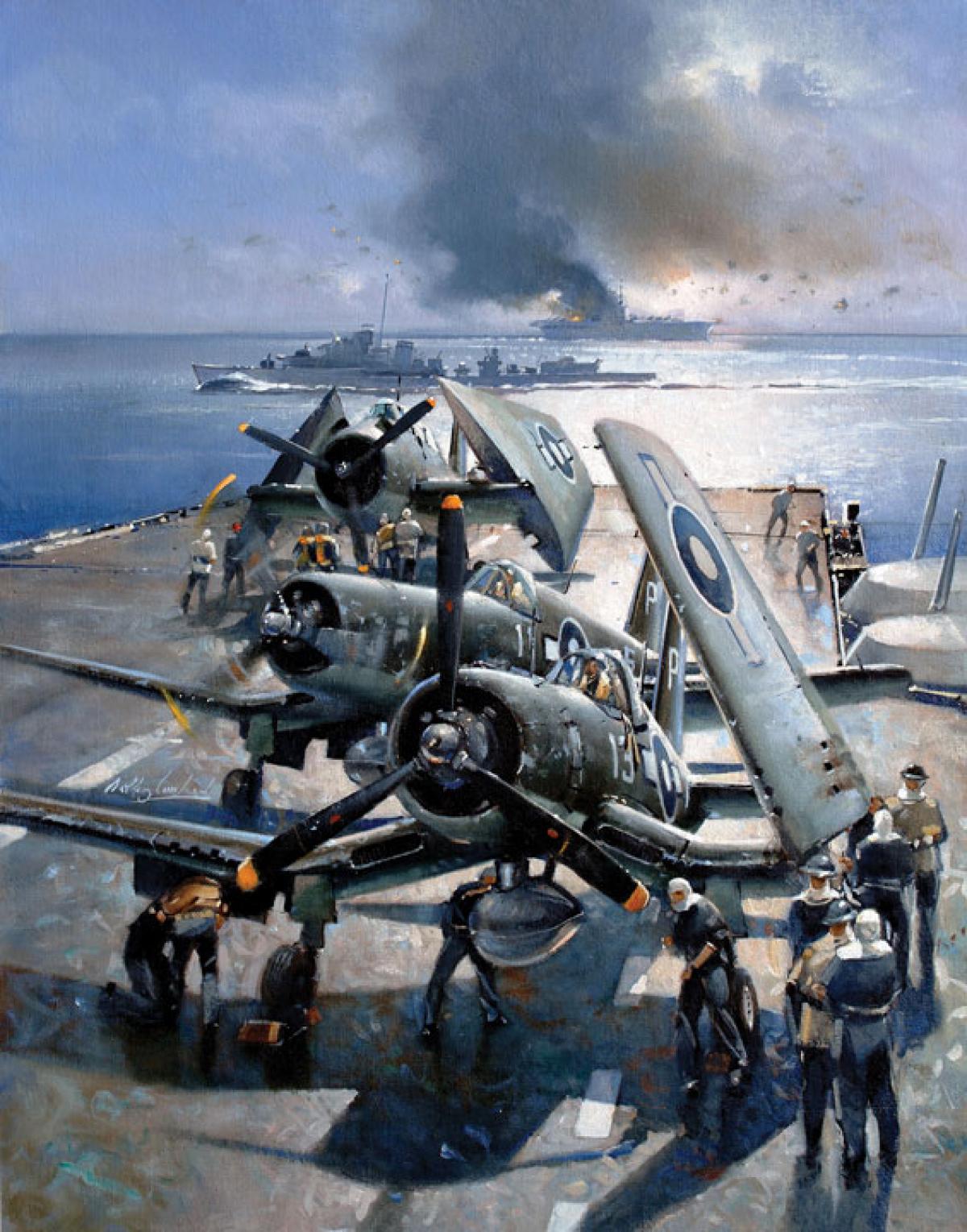
The British battlecruiser HMS Renown operating with other capital ships of the British Eastern Fleet in the Indian Ocean area, 12 May 1944. The battleship HMS Valiant is in the right distance. The French battleship Richelieu is in the left background.
While naval power had contributed mightily to the rolling up
of the Japanese Empire in the Pacific from the Battle of the Coral Sea onwards,
it had been much less influential in dictating the progress of the war in the
littoral states of the Indian Ocean. This was about to change in January 1945
with the success of the third Arakan offensive. A start was made with Operation
Lightning on 2 January when Rear-Admiral Bernard Martin left Chittagong with TF
64, part of Vice-Admiral Sir Arthur Power’s British East Indies Fleet (BEIF),
to put 1,000 Commandos ashore on the Akyab Peninsula so that they could capture
the port city of Akyab (Sittwe) from which Japanese troops had already
withdrawn. Securing Akyab would provide the Allies fighting in northern Burma
with a very useful port for the landing of both additional troop reinforcements
and sup- plies – a point underlined by the landing shortly thereafter of the
Indian 74th Brigade. A few days later TF 64 was again on hand to land more
Commando units further south near Myebon on Hunter Bay (Operation Passport).
These were small-scale affairs and mere precursors for Operation Matador which
put the British 4th and Indian 71st Brigades ashore from eighty-four landing
craft on the northern coast of Ramree Island off the Arakan coast on 16
January. Martin, with his ?ag in the Australian destroyer Napier, was assisted
in this enterprise by the presence of a ?re support group, containing the
battleship Queen Elizabeth, which pounded the landing sites ahead of the
invasion and by an air wing pro- vided by the escort carrier Ameer which soon
proved its worth by repelling an attack on the invasion fleet by eighteen
Japanese aircraft bent on its destruction. Another incremental incursion
followed on 26 January with the landing further south on Cheduba Island
(Operation Sankey) of 500 Marines and an even smaller contingent found their
way to the island of Sagu Kyun on 30 January (Operation Pendant).
Power’s BEIF may have been sufficient for mopping up what
was left of Japanese resistance on the Burmese coast, but it was not sufficient
to take issue with the real centres of enemy power concentrated around the oil
industry in the Indian Ocean and the South China Sea. For these the four
carriers Illustrious, Indefatigable, Indomitable and Victorious of the British
Pacific Fleet (BPF) were required not only to cope with the threat posed by the
Japanese land-based air- craft, but also to deal effectively with onshore refineries
that were situated, for example, in the hinterland of Sumatra, so far removed
from the coast that they were not accessible to even the guns of the largest
battleships. If the BPF was going to be representative of its name, however, it
would need to move much closer to the Pacific than Trincomalee. So on 16 January
Admiral Fraser steamed eastwards away from the Ceylonese naval base with the
battleship King George V, all four carriers (listed above), three light
cruisers and nine destroyers in order to get much closer to the scene of the
action. Also known as TF 63, the BPF would collect the light cruiser Ceylon, a
couple of destroyers and four oil tankers en route to Sumatra before making a
successful surprise attack on the oil refineries of Pladjoe (Plaju) and Soengi
Gerong near Palembang in late January (Operation Meridian). In this operation
Vian’s carrier planes destroyed 132 Japanese planes for the loss of forty-eight
of his own aircraft – more of which succumbed to crash landings rather than
enemy action. Air frames could be replaced, but experienced air crew were
always at a premium and in this respect the Japanese war effort was doubly hit,
losing far more planes and pilots than the Allies did in the Pacific and
failing to replace either with the same urgency and dispatch.
In the Indian Ocean the IJN no longer featured. Their
military was being pushed back relentlessly in Burma with bridgeheads being
established across the River Irrawaddy both north and south of Mandalay by
mid-February and the supply route to and from China – the Burma Road – having
been re-opened for business by 27 January. What naval activity there was in
this theatre was mostly, if not exclusively, generated by the Allies. While for
the most part this meant the British East Indies Fleet, Indian vessels were
also employed in bringing additional troops to bear on the Burmese front. In
this way the sloops Jumna and Narbada oversaw the landing of 6,635 Commandos
and other units on the banks of the Myebon River on 22-23 February.
Nonetheless, the BEIF was the usual naval catalyst for Allied action in the
early months of 1945. Apart from maintaining a lively presence in and around
the Andaman Islands, where its ships took turns to raid Japanese coastal
shipping and shell the infrastructure of Port Blair on a monthly basis, the
BEIF also conducted reconnaissance surveys of the Isthmus of Kra, Sumatra,
Penang and other ports on the Malayan coast as far south as Port Dickson
(Operation Stacey) in late February and early March, and indulged itself in
raids on oil installations on Sumatra (Operation Sunfish) in mid- April. This
type of activity could be planned in these days without too many safety
concerns as the last of the German U-boats sent out to East Asia had returned
to Germany in the early months of 1945.